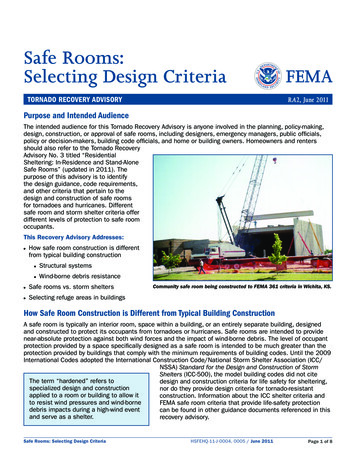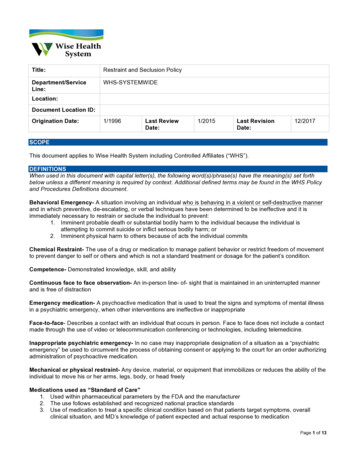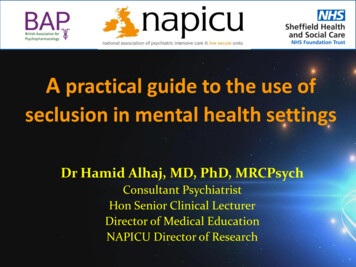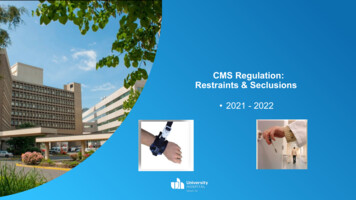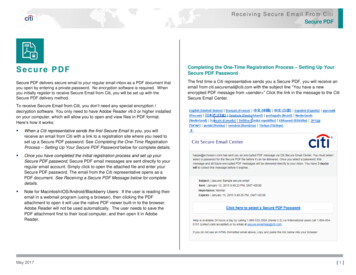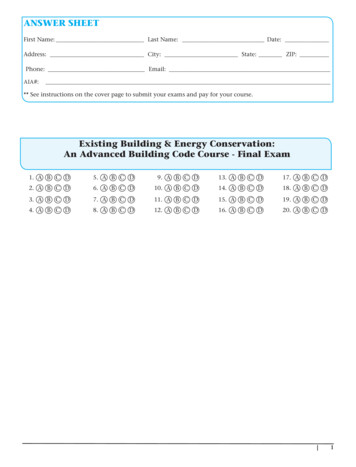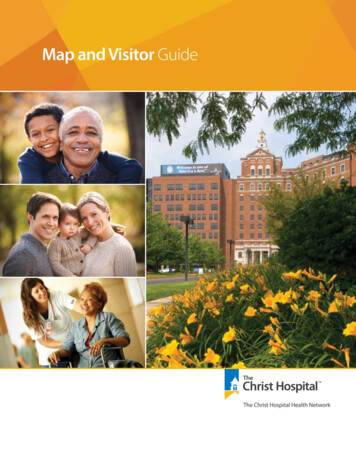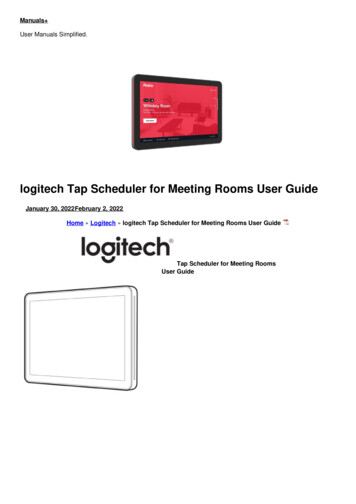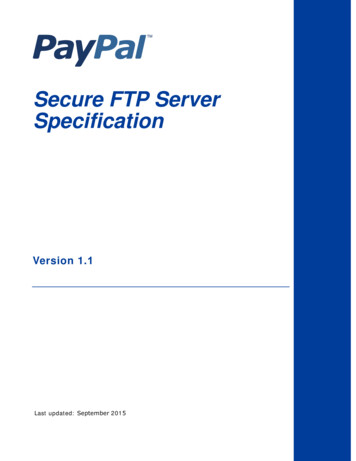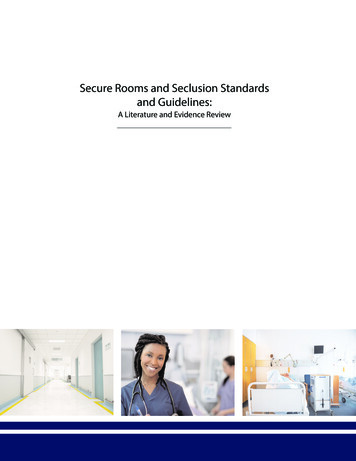
Transcription
Secure Rooms and Seclusion Standardsand Guidelines:A Literature and Evidence Review1
Ministry of HealthSeptember 2012
Secure Rooms and Seclusion Standards & Guidelines – A Literature & Evidence ReviewTable of ContentsExecutive Summary .11. Introduction .6A. Secure room and seclusion standards: context and purpose.6Rationale .6Structure: literature & evidence review.6Terminology and the continuum of care .7Methodology .7Defining best practice .8B. Existing standards and current practice .9Variation in environments .9Variation in populations.102. Literature & Evidence Review .12A. Best practice: preventing and minimizing seclusion.12Evidence base .12Evidence-based treatment .14Preventing seclusion and achieving minimization .18B. Safety and quality of care in the delivery of seclusion: program elements .29Evidence base .29Patient-centered service delivery .31Protect emotional wellbeing .32Monitor and protect physical health.34Debrief after each seclusion incident .35Continuous training for staff .36C. Safety and quality of care: secure room environment and design .40Evidence base.40Placement .40Communication and engagement tools .41Walls, floors and ceilings.41Windows.42Lighting.42Doors and locks .42Sanitation .44Airflow and temperature .44Safety precautions .44
Secure Rooms and Seclusion Standards & Guidelines – A Literature & Evidence ReviewTable of Contents cont.Works consulted. 45-54Appendix A: Designations under B.C.’s Mental Health Act .55-57Appendix B: Expert consultations performed for this review.58Appendix C: Comparative summary - cross-jurisdictional scan of seclusion andsecure room standards and guidelines .59-112Appendix D: Six Core Strategies to Reduce the Use of Seclusion and Restraint inInpatient Facilities .113Appendix E: Engagement Model .114Appendix F: Diagram of a seclusion suite .115
Secure Rooms and Seclusion Standards & Guidelines – A Literature & Evidence ReviewAcknowledgmentsThis report has been developed on behalf of the Provincial Mental Health andSubstance Use Planning Council in consultation with stakeholders in the healthauthorities, national and international stakeholders. The contributions and cooperationof a variety of individuals and groups should thus be acknowledged.Ministry of HealthMonica Flexhaug, manager and project lead, Mental Health and Substance UseGerrit Van der Leer, director, Mental Health and Substance UseSecure Rooms Standards Steering CommitteeAlisa Y. Harrison, PhD,Principal, A. Harrison Research and ConsultingBeth Ann Derksen, Northern HealthLois Dixon, Fraser HealthDerek Dobrinsky, Northern HealthSherri Hevenor, Northern HealthLisa McMurray, Fraser HealthTwyla Rickman, Fraser HealthAdditional ConsultationsA number of clinicians and researchers outside of British Columbia graciouslyconsented to be interviewed, thus supporting the preparation of thecross-jurisdictional analysis as well as interpretation of the research literature. Dr. Maggie Bennington-Davis, chief medical and operating officer, Cascadia BHC(Portland, Oregon, USA) Paolo del Vecchio, SAMHSA, acting director, Center for Mental Health Services (USA) Dr. Bob Glover, executive director, National Association of State Mental HealthProgram Directors (USA) Kevin Ann Huckshorn, director, Substance Abuse and Mental Health, State ofDelaware (USA) Dr. Paul Links, chair/chief, Department of Psychiatry, University of Western Ontario Mary O’Hagan, mental health commissioner (New Zealand) Glenna Raymond, CEO (CHE), Ontario Shores Mental Health Centre for Mental HealthSciences (Whitby, Ontario) Sharon Simons, co-lead, Seclusion/Restraint Reduction, St. Joseph’s Hospital(Hamilton, Ontario) Dr. Arne Vaaler, psychiatrist, Ostmarka Psychiatric Department, St. Olavs Hospital(Norway) Dr. Phil Woods, associated dean, Research, Innovation and Global Initiatives,College of Nursing, University of Saskatchewan Dr. Leslie Zun, Department of Emergency Medicine, Finch University(Chicago, Illinois, USA)
Secure Rooms and Seclusion Standards & Guidelines – A Literature & Evidence ReviewExecutive SummarySecure room and seclusion standards: context and purposeThe Ministry of Health is interested in developing standards for secure rooms and thedelivery of seclusion as part of a process of developing overall standards of health,quality of care and safety for B.C.’s designated facilities. This report provides the clinical,professional and policy evidence base from which to generate secure room andseclusion standards. It synthesizes recently published academic, government and grayliterature; a cross-jurisdictional scan of existing standards and guidelines for securerooms and seclusion; and consultations with international experts in order to identifybest practice for service delivery, which is underwritten by a proactive focus onminimizing the use of seclusion whenever possible.TerminologyThis evidence review focuses on the practice of seclusion, defined as a physicalintervention that involves containing a patient who is perceived to be in psychiatriccrisis in a room that is either locked or “from which free exit is denied” (Mayers et al.,2010, p. 61). An individual who has been contained and prevented from leaving a spacein the course of a psychiatric intervention is considered to be experiencing seclusion,whether or not the intervention is carried out in a formal secure room or any otheralternatively-labeled environment, including a patient’s hospital bedroom. There issignificant variation in the terminology used to describe the places in which seclusioninterventions occur. Consistent with Accreditation Canada’s approach, this report usesthe term secure room exclusively to refer to the room in which a seclusion interventionshould be delivered.Existing standards and current practiceAlthough seclusion practices internationally are insufficiently regulated at present andexisting standards vary, a review of standards and guidelines reveals a number ofcommon elements that could be seen as providing basic requirements for the practiceof seclusion. These basic requirements typically focus on maintaining patients’ dignityand safety as well as improving clinical oversight and accountability. However, the mostsignificant central point, common to standards and guidelines across every jurisdictionsurveyed and reflected widely in both the academic and policy literature, is thatseclusion should be an intervention of absolute last resort. Seclusion poses a highdegree of risk to patients and staff, and most researchers agree that it is of no proventherapeutic value. When physical intervention is unavoidable, it should be deliveredaccording to clear standards of practice, documented, and reported appropriately.1
Secure Rooms and Seclusion Standards & Guidelines – A Literature & Evidence ReviewExisting standards and current practice cont.Variation in environments and populationsThe spaces available for seclusion in B.C.’s designated facilities vary widely dependingon whether they are located in inpatient psychiatric, observation or tertiary units; inurban or rural hospitals; or in emergency departments. Seclusion in the uniqueenvironment of an emergency department requires a particular focus that is beyondthe scope of the present project.While the literature indicates that standards of care apply equally across populations,some groups (children and adolescents, people with developmental disability,psycho-geriatric populations) have particular needs that may warrant extra vigilancewhen delivering or preventing seclusion. The literature on best practice in psychiatricintervention overall supports adapting the delivery and prevention of seclusion inorder to maximize cultural competence and sensitivity to gender-specific concerns.Literature and evidence review:best practice for safety and quality of careThe present report addresses best practice in three categories: minimizing seclusion,program elements for safety and quality of care in the delivery of seclusion, and secureroom environment and design.Preventing or minimizing seclusionStandards and guidelines across jurisdictions provide direction for the safe delivery ofseclusion when the intervention cannot be prevented. Research evidence and expertconsultation across all jurisdictions emphasize that when seclusion is delivered, it mustbe within an overarching framework that actively promotes minimization, reduction,or in some places elimination. Whereas many jurisdictions focus on reduction andelimination, the primary approach to changing the practice of seclusion in Canada maybest be described as minimization.All evidence suggests that an environment that promotes prevention orreduction/minimization is a prerequisite for the safe delivery of seclusion whenthe intervention is necessary and unavoidable. Prevention and reduction/minimization initiatives set the stage for a facility culture that emphasizes thesimultaneous need to ensure staff and patient safety (staff safety depends on patientsafety, and vice versa); prioritizes staff education and support so that staff have thetools with which to provide patient-centered care in a safe and appropriateenvironment; and recognizes the need for strong leadership committed totransparency, monitoring and oversight.2
Secure Rooms and Seclusion Standards & Guidelines – A Literature & Evidence ReviewLiterature and evidence review: best practice for safety and quality of care cont.The goal of preventing or minimizing the use of seclusion flows logically from arecovery-oriented, person-centered, trauma-informed perspective on inpatientpsychiatric care, for which there is an already-strong and growing evidence base, andwhich is being adopted widely across jurisdictions. This type of approach to treatmentrecognizes that people at risk of or experiencing seclusion are particularly vulnerableand require interventions that take their specific histories and individual needs intoaccount.Two frequently-cited frameworks for preventing and reduction/minimization, bothfrom the United States and rooted in trauma-informed practice, are the Six CoreStrategies for the Reduction of Seclusion and Restraint in Inpatient Facilities (seeAppendix D) and the engagement model (Appendix E), articulated most fully in thiscontext in Murphy & Bennginton-Davis’ Restraint and Seclusion: The Model ofEliminating their Use in Healthcare (2005).Recommendations for achieving minimization synthesize the guidelines provided byboth of these frameworks, as well as other useful contributions within the reductionliterature. These recommendations include: develop an explicit reduction or minimization initiative; build a culture of empowerment and respect based in patient-centred principles; ensure that services follow recovery-oriented, trauma-informed practice; provide strong oversight and leadership that actively supports minimization andmanages risk; implement specific measures to prevent seclusion; document and report on seclusion to allow evidence to drive practice and fosterorganizational change; support staff to value patients’ dignity and empowerment; provide staff with opportunities for continuous training and professionaldevelopment; acknowledge and address staff concerns about violence; and partner with patients and consumers to improve treatment and service delivery.Delivering seclusion: program elementsGiven the known risks involved, it is critical that clinicians and other professionalsprioritize safety and quality of care when delivering seclusion. When seclusion musttake place, it is a short-term, emergency intervention designed to protect and enhancethe safety of the individual patient and others on the unit. Seclusion should take placeonly in a room designed and designated specifically for that purpose, conform toprotocols that are part of a facility’s standard operating procedure, and not be deliveredon an ad hoc basis.3
Secure Rooms and Seclusion Standards & Guidelines – A Literature & Evidence ReviewLiterature and evidence review: best practice for safety and quality of care cont.Because of patients’ vulnerability, staff should ensure that they treat patients with careand respect, and monitor their physical and emotional health and wellbeing. Followingany incident of seclusion, staff must document the entire process thoroughly, andconduct debriefing sessions that involve facility leaders, and the patient and/or anadvocate.Delivery of seclusion should be based on best practices that include the following: provide patient-centred care that accounts for patients’ views, expectations andcritiques; care for patients’ emotional wellbeing by maintaining constant contact andcommunication between patient and staff throughout every incident ofseclusion; care for patients’ physical health by attending to their basic needs at all timesand delivering seclusion using methods that protect them from injury and harm; follow a two-step debriefing process after each incident, including facilityleaders, staff, and the patient and/or advocate; and provide continuous training for staff involved with service delivery.Secure room environment and designSeclusion should take place only in a room designed expressly for that purpose. In newbuildings, the location of the secure room should be determined early in the designprocess, and all decisions about the secure environment should be made jointlybetween the architect or builder and an appointed clinical liaison.The design of the secure area has a direct impact on a patient’s treatment and staffsafety. Studies of patients’ perceptions suggest that seclusion experiences often feelpunitive rather than therapeutic, largely because of inadequate seclusionenvironments. Secure room design should focus equally on safety and functionality,ensuring that the room protects the patient at all times and is durable enough towithstand potential abuse.The secure room should be designed to minimize the traumatic potential of seclusioninterventions. It must be placed near enough to the nursing station to enable constantobservation of the patient through the observation window, and away from areas thatare the site of frequent non-clinical interaction, as well as elevators, stairs and exits.Closed-circuit television and an intercom that staff may turn down but not off arecritical tools enabling staff to engage with and assess the secluded patient.4
Secure Rooms and Seclusion Standards & Guidelines – A Literature & Evidence ReviewLiterature and evidence review: best practice for safety and quality of care cont.Design features for secure rooms recommended in the literature and by experts inthe field include: adequate size, large enough to accommodate up to six staff members(approximately 50 square feet); limited furnishings; no safety hazards; durable, tamper- and impact-resistant features; seamless walls and floors, which may be padded; calming colour scheme (not grey or white); high ceilings (three metres height); unbreakable exterior window that provides natural light and is positioned toenable a view outside; securely mounted, unbreakable lighting operated on patient request; secure, heavy-duty door with glazed observation panel; external door locks set to unlock automatically in case of fire alarm; robust sanitary facilities; adequate airflow and healthy air temperature; and appropriate safety mechanisms, including a staff-operated alarm system andcarefully mounted security mirrors.5
Secure Rooms and Seclusion Standards & Guidelines – A Literature & Evidence Review1. IntroductionA. Secure room and seclusion standards: context and purposeThere are approximately 28,000 admissions (20,000 unique individuals) to psychiatricunits across British Columbia each year1. These people and their families, caregiversand communities require evidence-based, client-centered treatment that: ensures thehealth and safety of every person in psychiatric care; continues to improve servicedevelopment; and furthers the integration of services within a continuum of care. TheMinistry of Health is interested in developing standards and guidelines for securerooms and the delivery of seclusion as part of a process of developing overall standardsof health, quality of care and safety for B.C.’s designated facilities.RationaleWhile there are a variety of regulatory and quality standards governing B.C.’s designatedfacilities, it is unclear if any one approach is comprehensive enough to address allhealth and safety risk elements. Moreover, a review of B.C.’s Mental Health Act, HospitalAct, and Community Care and Assisted Living Act demonstrates that at present, nospecific legislated quality, health and safety rules apply to care provided in designatedfacilities2.An absence of health and safety rules poses a potential risk to patients and staff, andcreates inconsistency in service parameters and guidelines for individuals receivingservices in these facilities. This paper, therefore, provides the clinical, professional andpolicy evidence base from which to generate secure room and seclusion standards andguidelines. It synthesizes recently published academic, government and gray literature;consultations with international experts in the field; and a cross-jurisdictional scan ofexisting standards and guidelines for secure rooms and seclusion in order to identifybest practice for service delivery, which is underwritten by a proactive focus onminimizing the use of seclusion whenever possible.Structure: literature & evidence reviewThe literature and evidence review (part two of this paper) is divided into four sections,each of which focuses on particular aspects of ensuring safety and quality of care.Section A explains that seclusion must be delivered within a framework that isintrauma-informed, recovery-oriented, and patient-focused, and which encompassesinitiatives geared explicitly toward reducing or minimizing the use of seclusion. SectionB then addresses key program elements for delivering seclusion when the interventioncannot be avoided. Finally, Section C considers the evidence for safe secure roomdesign, acknowledging the critical importance of an appropriately-built environmentwhen delivering this complex intervention.1Data provided by the Ministry of Health, Mental Health & Substance Use Branch, accessed via Quantum Analyzer.See Appendix A for a complete listing of B.C.’s designated facilities.26
Secure Rooms and Seclusion Standards & Guidelines – A Literature & Evidence ReviewA. Secure room and seclusion standards: context and purpose cont.Terminology and the continuum of careSeclusion is aphysical interventionduring which a patientperceived to be in psychiatric crisis is contained in a room that iseither locked or “fromwhich free exit isdenied.”Source: Mayers et al.,2010, p. 61.There is significant variation in the terminology used to describe the places in whichseclusion interventions occur. Consistent with Accreditation Canada’s approach, thisliterature review uses the term secure room exclusively to refer to the room in which aseclusion intervention should be delivered. Facilities around the province useadditional terms including quiet room and time-out room to refer to the same oressentially the same type of space. This review will not use those terms for threereasons: they are not typical in the literature; to emphasize that there is only one type of highly specialized space in which it isacceptable for seclusion to be delivered; and to suggest the benefit to the overall system of care of facilities in British Columbiaadopting consistent language to refer to the space designated for this practice.In terms of the intervention itself, this review focuses on the practice of seclusion.Seclusion is defined as a physical intervention during which a patient perceived to bein psychiatric crisis is contained in a room that is either locked or “from which free exitis denied” (Mayers et al., 2010, p. 61). An individual who has been contained andprevented from leaving a space in the course of a psychiatric intervention is consideredto be experiencing seclusion, whether or not the intervention is carried out in a formalsecure room or other alternatively-labeled environment, including a patient’s hospitalbedroom.Much of the literature considers seclusion in tandem with restraint (physical andchemical) because of the considerable overlap between the two practices. This review,however, addresses policy and practice relating only to seclusion.MethodologyRelevant literature was identified using a variety of online databases (Google, GoogleScholar, EBSCO, CINAHL and the Cochrane library) to search for discussions and studiesof best practice in delivering seclusion and designing secure rooms. Comprehensivesearches uncovered clinical and academic literature from across disciplines includingsocial work, nursing, medicine, psychology and psychiatry, as well as policy documentsfrom a variety of government and non-governmental organizations (NGOs). In mostcases, searches concentrated on literature produced since 2000, such that it wouldreflect the significant developments over the past decade in behavioural health care.However, in exceptional cases and where there was a paucity of recent material,documents published prior to this period were considered.7
Secure Rooms and Seclusion Standards & Guidelines – A Literature & Evidence ReviewA. Secure room and seclusion standards: context and purpose cont.The cross-jurisdictional scan identified existing standards and guidelines for securerooms and seclusion in Canada, the United States, the United Kingdom, Australia andNew Zealand, as well as examples from Europe and South Africa. These standards andguidelines vary in their degree of comprehensiveness, and also in the degree to whichone might discern the evidence on which they are based. Standards were locatedthrough internet searches using Google and Google Scholar; consulting governmentand NGO websites; as well as by following citations found in research and policyliterature.Following a thorough but not exhaustive review of published evidence, consultationswere conducted with approximately a dozen experts across jurisdictions in order toenhance understanding of current notions of best practice, and leading thinking in thefield. A large number of requests for consultation were made via e-mail, andconsultations were conducted by telephone or Skype with all who responded withinthe allotted research timeline3 .Defining best practiceTypically, a practice is considered best, recommended or leading when it is supportedby robust evidence. In the case of secure rooms and the delivery of seclusion, ethicalconsiderations and other factors preclude the most stringent empirical research.According to a Cochrane review, the literature includes very few well-designedexperimental studies, and no controlled examinations of service delivery or design(Sailas & Fenton, 2009). Although the literature does include less rigorous experimentalstudies as well as numerous excellent qualitative, exploratory and descriptive analyses,a variety of researchers concur that the delivery of seclusion requires further study(Kallert et al., 2005; Borckhardt et al., 2007; Johnson, 2010; Zun & Downey, 2005).In the last 15 years, however, researchers appear to have shifted their focus away fromdelivery of seclusion in and of itself, and toward delivery in the context of prevention,reduction, and/or elimination of seclusion. In the process, they have generated a richcomplementary body of literature, which expands the issue’s scope and complexity,and introduces evidence gleaned from both quantitative and qualitative researchdesigns.Designating a practice as best, therefore, has depended on the level of support foundwithin the literature on delivery, reduction, elimination, and/or prevention, combinedwith strong clinical consensus reflected in the testimony of key expert clinicians andadministrators consulted across several jurisdictions.3Appendix C contains a summary of existing standards and guidelines, indicating the variety of approaches aswell as the common elements across jurisdictions.8
Secure Rooms and Seclusion Standards & Guidelines – A Literature & Evidence ReviewB. Existing standards and current practiceA specific focus onemergency departmentsis required in order to ensure safe and effectiveservice delivery, andstrong linkages and continuity of care throughout units within adesignated facility.Seclusion is an intervention of absolutelast resort, which poses ahigh degree of risk to patients as well as careproviders, and is of lowto no proven therapeuticAt present, seclusion practices internationally are insufficiently regulated, especiallygiven the high risks it poses to patient safety and the legal risks to which it exposescare providers (Kontio, 2011; Haimowitz et al., 2006; Huckshorn, 2006a; Muir-Cochraneet al., 2002). Existing standards provide basic requirements for the practice of seclusion,but there can be significant variation even within a single jurisdiction, and thestandards are rarely binding, thus allowing facilities a great deal of leeway in terms ofcompliance.Within this context, standards and guidelines across jurisdictions do appear linked bya number of common elements. They typically focus on maintaining patients’ dignityand safety as well as improving clinical oversight and accountability. The latter is criticalconsidering how often seclusion is under-reported (Kontio, 2011; Haimowitz et al.,2006; Huckshorn, 2006a; Muir-Cochrane et al., 2002).The most significant central point, common to standards and guidelines across everyjurisdiction surveyed and reflected widely in both the academic and policy literature,is that seclusion should be an intervention of absolute last resort. Seclusion poses ahigh degree of risk to patients, and most researchers agree that it is of low to no proventherapeutic value (for example, LeGris et al., 1999; Happell & Harrow, 2010; Haimowitzet al., 2006; PPAO, 2001; Borckhardt et al., 2007; Isherwood, 2006; Powell et al., 2008;Kontio, 2011; Sailas & Fenton, 2009).Existing standards thus reflect a common claim that facilities should prevent thisintervention whenever possible using a variety of less restrictive techniques. Whenphysical intervention is unavoidable, it should be delivered according to clear standardsof practice, documented, and reported appropriately.Variation in en
when delivering or preventing seclusion. The literature on best practice in psychiatric intervention overall supports adapting the delivery and prevention of seclusion in order to maximize cultural competence and sensitivity to gender-specific concerns. The present report addresses best practice in three categories: minimizing seclusion,
